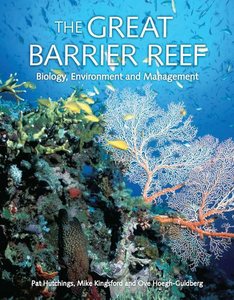Pelagic Cnidaria and Ctenophora
Gershwin, L., and Kingsford, M.J. (2008) Pelagic Cnidaria and Ctenophora. In: Hutchings, Pat, Kingsford, Mike, and Hoegh-Guldberg, Ove, (eds.) The Great Barrier Reef: biology, environment and management. CSIRO Publishing, Collingwood, VIC, Australia, pp. 188-198.
![[img]](https://researchonline.jcu.edu.au/7469/2.hassmallThumbnailVersion/7469_Gershwin_and_Kingsford_2008_cover.jpg)
|
Image (JPEG) (Book Cover)
- Cover Image
Download (150kB) |
|
|
PDF (Published Version)
- Published Version
Restricted to Repository staff only |
Abstract
The jellyfishes are conspicuous, but poorly understood, members of the Great Barrier Reef (GBR) fauna. Much attention has been given over the past 50 years to two forms in particular, the so-called 'box jellyfishes' and 'Irukandjis', both of which are highly dangerous and are known to kill humans. However, the dangerous species comprise only a small fraction of the jellyfishes that make their home in the GBR region.
Jellyfishes in general are among the most intriguing of animals, because they tantalise the child in all of us with their strange shapes, often bright colours, and sometimes flashing lights, and yet, even the milder stinging varieties seemingly represent the forbidden signal: DO NOT TOUCH!
While appearing to be simple creatures consisting of no more than mucus and stinging cells, jellyfish have great potential to alter ecosystems through predation and uptake and excretion of nutrients. The medusa stage is the most obvious and often the most voracious part of the life cycle; however, the polyp stage represents the 'seed bank' of the species, making most jellyfish species incredibly difficult, if not impossible, to eradicate.
Several well-studied cases exist of jellyfish species being introduced to exotic environments and causing great harm to the ecosystem in the process (e.g. Mnemiopsis in the Black Sea and Phyllorl1iza in the Gulf of Mexico). In other cases, serious impacts on the local biota have been caused by extreme concentrations of native species (e.g. blooms of Chrysaora in the Gulf of Alaska and Aurelia in California).
Jellyfish can also be a food source for many species, such as fishes and turtles, and they are heavily fished in some parts of the world (e.g. China).
| Item ID: | 7469 |
|---|---|
| Item Type: | Book Chapter (Research - B1) |
| ISBN: | 978-0-643-09557-1 |
| Keywords: | Irukandjis; jellyfish; Ctenophore; cnidaria; Great Barrier Reef; marine sciences |
| Date Deposited: | 21 Dec 2009 23:41 |
| FoR Codes: | 05 ENVIRONMENTAL SCIENCES > 0502 Environmental Science and Management > 050202 Conservation and Biodiversity @ 100% |
| SEO Codes: | 96 ENVIRONMENT > 9605 Ecosystem Assessment and Management > 960507 Ecosystem Assessment and Management of Marine Environments @ 100% |
| Downloads: |
Total: 238 Last 12 Months: 2 |
| More Statistics |



